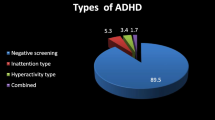Abstract
Objectives
To study the prevalence of parent-rated attention deficit hyperactivity disorder and associated parent-related factors in primary school children of Navi Mumbai.
Methods
One hundred twenty two children including both boys and girls aged between 6 y and 11 y were selected from a school at Navi Mumbai and their parents were given the National Innovative for Children’s Healthcare Quality (NICHQ) Vanderbilt Assessment Scale to be filled and returned, which was subsequently analyzed using SPSS (version 16).
Results
The prevalence of attention deficit hyperactivity disorder was 12.3 % with boy to girl ratio of 3:2. It was more prevalent in nuclear type of family and in families where a single parent was working especially where the father was the sole breadwinner and doing semi-skilled or unskilled type of work. No significant relation was found between the numbers of work-related hours when parents were away from children and attention deficit hyperactivity disorder.
Conclusions
Attention deficit hyperactivity disorder is prevalent in the primary school-going population of Navi Mumbai, especially in boys. The increased prevalence in nuclear families and families with single working parent should further be explored. Further studies with larger sample size and longer period of follow up may be recommended. The study also recommends screening of school children for symptoms of attention deficit hyperactivity disorder (ADHD) for early diagnosis and treatment.
Similar content being viewed by others
References
American Psychiatric Association. Diagnostic and statistical manual of mental disorders. 4th ed. Washington: American Psychiatric Association; 2000.
Faraone SV, Biederman J, Weber W. Psychiatric, neuropsychological, and psychosocial features of DSM-IV subtypes of attention-deficit/hyperactivity disorder: Results from a clinically referred sample. J Am Acad Child Adolesc Psychiatry. 1998;37:185–93.
Fitzgerald M, Bellgrove M, Gill M. Handbook of attention deficit hyperactivity disorder. England: John Wiley &Sons Ltd; 2007.
Elia J, Ambrosini PJ, Rapoport JL. Treatment of attention-deficit-hyperactivity-disorder. N Engl J Med. 1999;340:780–8.
Taylor E. Syndromes of attention deficits and overactivity. Child and adolescent psychiatry modern approaches. 3rd ed. London: Blackwell; 1994.
Bhatia MS, Bohra VR, Malik SC. Attention deficit disorder with hyperactivity among pediatric outpatients. J Child Psychol Psychiatry. 1991;32:297–306.
Khushabhi K, Pour-Etemad H, Mohammadi M, Mohammadkhani P. The prevalence of ADHD in primary school students in Tehran. Med J Islam Repub Iran. 2006;20:147–50.
McArdle P, O’Brien G, Kolvin I. Hyperactivity prevalence and relationship with conduct disorder. J Child Psychol Psychiatry. 1995;36:279–303.
Choudhary S, Bhatia MS, Bhutani S, Sidana A. Attention deficit hyperactivity disorder—a review. Indian J Med Sci. 1999;53:299–309.
Gada M. A study of prevalence and pattern of attention deficit disorder with hyperactivity in primary school children. Indian J Psychiatry. 1987;29:113–8.
Susan BL. Understanding attention deficit hyperactivity disorder. Jackson, Mississippi: University Press of Mississippi; 2007.
Al Hamed JH, Taha AZ, Sabra AA, Bella H. Attention deficit hyperactivity disorder (ADHD): Is it a health problem among male primary school children. Bahrain Med Bull. 2008;30:1–9.
Sadock BJ, Sadock VA. Attention deficit disorders. In: Sadock BJ, Sadock VA, eds. Kaplan and Sadock’s synopsis of psychiatry. 10th ed. Philadelphia: Lippincott Williams and Wilkins; 2007. pp. 1206–17.
Hoch EM. Indian children on psychiatrist playground. NewDelhi: Indian Council of Medical Research; 1967.
McCracken JT. Attention deficit disorders. In: Sadock BJ, Sadock VA, eds. Comprehensive textbook of psychiatry. 3rd ed. Philadelphia: Lippincott Williams and Wilkins; 2000. pp. 2679–86.
Barnett RC. Toward a review and reconceptualization of the work/family literature. Genet Soc Gen Psychol Monogr. 1998;124:125–82.
Bogen K, Joshi P. Bad work or good move: The relationship of part-time and nonstandard work schedules to parenting and child behavior in working poor families. Paper presented at: low income families-coping as parents and workers conference, sponsored by U.S. Department of Health and Human Services, Chapin Hall and NCCP, Washington, DC; 2001.
McIntosh KL. Working mothers versus stay at home mothers: the impact on children. OhioLINK ETD [Internet] 2006 [cited 2011Sep 15] Available from: http://etd.ohiolink.edu/view.cgi?acc_num=marietta1144855683.
American Academy of Pediatrics. National Initiative for Children Healthcare Quality (NICHQ) [Internet] 2002 [cited 2011Sep 15] Available from: http//www.nichq.org/toolkits_publications/…/07Scoring%20Instructions.pdf
Plackett RL. Karl Pearson and the Chi-squared test. Int Stat Rev (Int Stat Inst). 1983;51:59–72.
Malhi P, Singhi P. Spectrum of attention deficit hyperactivity disorder in children among referrals to psychological services. Indian Pediatr. 2000;37:1256–60.
Bassa DM. An analysis of cases attending child psychotherapy centers. Indian J Child Health. 1962;11:396–402.
Ben M. Causes of attention deficit disorder. [Internet] 2007 [cited 2011Sep 15] Available from: http://psychcentral.com/lib/2007/causes-of-attention-deficit-disorder-adhd/.
Contributions
SA; Conceptualization of study, data analysis and interpretation, writing of manuscript, DK; Data interpretation and writing of manuscript, AG; Data collection, PJ; Data analysis.
Conflict of Interest
None.
Role of Funding Source
None.
Author information
Authors and Affiliations
Corresponding author
Rights and permissions
About this article
Cite this article
Ajinkya, S., Kaur, D., Gursale, A. et al. Prevalence of Parent-Rated Attention Deficit Hyperactivity Disorder and Associated Parent-Related Factors in Primary School Children of Navi Mumbai—A School Based Study. Indian J Pediatr 80, 207–210 (2013). https://doi.org/10.1007/s12098-012-0854-1
Received:
Accepted:
Published:
Issue Date:
DOI: https://doi.org/10.1007/s12098-012-0854-1




